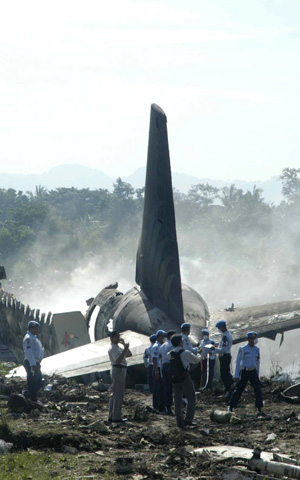Indonesia struggles to play it safe
Country’s internal transport links are blighted by appalling safety record.

 |
| Scenes like this are far too common in Indonesia [AFP] |
These days Indonesians are as familiar with fatal transport accidents as they are with natural disasters such as flooding and earthquakes.
It was Indonesia’s second deadly air crash in 2007 alone after an Adam Air Boeing 737 disappeared in Sulawesi in January with 102 passengers and crew on board.
Keep reading
list of 4 items‘Mama we’re dying’: Only able to hear her kids in Gaza in their final days
Europe pledges to boost aid to Sudan on unwelcome war anniversary
Birth, death, escape: Three women’s struggle through Sudan’s war
Already in 2007, as well as two serious air accidents, about 50 people died in a fire on a ferry travelling between Jakarta and the island of Bangka, and another five were killed and 100 injured when a train derailed in central Java.
Official government statistics would not offer comfort for anyone contemplating making a journey within Indonesia.
An incident involving an aircraft was reported every nine to ten days while every month an average of two rail accidents are reported.
Indonesia’s air safety is traditionally poor with Garuda, boasting one of the better records, having experienced nine fatal accidents involving its planes since 1970.
Crowded market
The relaxation of laws regulating airlines six years ago has increased safety risks, while stiff competition, fuelled by falling ticket prices, between a raft of new budget airlines means safety regulations are often ignored.
Just days before the Yogyakarta crash, Hatta Rajasa, the Indonesian transport minister, announced plans to ban local carriers from operating jetliners that are more than 10 years old.
However the average age of some 3,000 jets is around 10.5 years meaning huge investment would be needed to enforce the new regulations.
Aviation experts also point out that many aircraft much older than 10 years ply routes worldwide with far less safety concerns than in Indonesia.
One expert, Dudi Soedibyo, told Al Jazeera that Dakota planes dating back to 1956 still make regular flights.
He says it is the maintenance of planes that is the problem while others say that corruption is the real reason behind the appalling safety record.
In January an Adam Air pilot was sued for breach of contract by an Indonesian court and fined $10,000.
Sutan Solahudin was one of 16 pilots who had left the company saying the airline cut corners with regards to safety.
He told Al Jazeera that he was forced to fly a plane that was known to be broken by authorities and was subsequently shown on another occasion on amateur video making an emergency landing at an airfield in east Indonesia.
Many countries such as the UK advise their citizens to check the record of Indonesian airlines before they book and criticism from abroad and within the industry has compelled Susilo Bambang Yudhyono to form a troubleshooting team that has tackling corruption as a high priority.
Yet it seems it will take huge investment and a wholesale renovation of working practices before tragedies such as Tuesday’s crash are an exception rather than the norm.